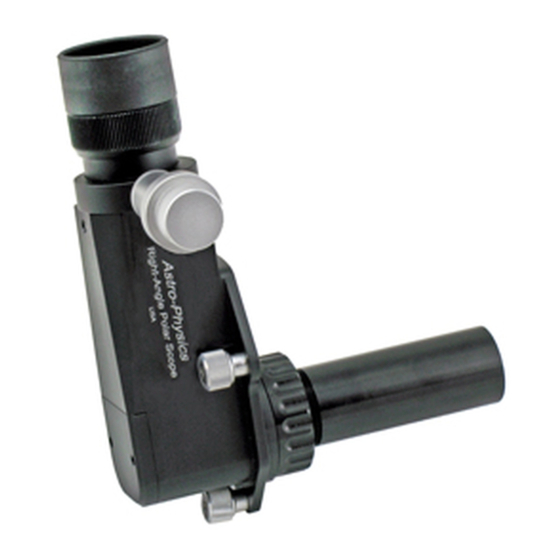ASTRO-PHYSICS RAPAS Manual de instrucciones - Página 5
Navegue en línea o descargue pdf Manual de instrucciones para Adaptador ASTRO-PHYSICS RAPAS. ASTRO-PHYSICS RAPAS 6 páginas. Right-angle polar alignment scope

Drift Alignment - R.A. Correction Method:
Classic drift align minimizes only Dec. drift over most of the sky. However, that results in significant R.A. drift
at the zenith. Drift in R.A. increases the closer you are to the Earth's equator. Why was this classic method
of drift align developed? It was developed this way because in times past most equatorial mounts had only
right ascension drives and no way to adjust declination drift. If you could eliminate Dec. drifting, then all you
needed was a drive corrector for the R.A. motor that would allow you to adjust the right ascension drive rate to
compensate for the R.A. drift, and you had a fairly nice unguided system and could take images.
Note: Align your CCD guide camera to be square with the R.A and Dec. axes of your mount. Know
which axis is R.A. and which is Dec. Assume nothing...test it.
The modified drift align is as follows: Do the classic Dec. align at the celestial equator/meridian using the
azimuth knobs. Don't worry about R.A. drift, just zero out Dec. drift there.
Note: Set your guiding aggressiveness to 0%. Watch only the Dec. line on the guiding graph. Adjust the
mount's azimuth until the star stays on the line and does not drift.
Once that is done, go to a star near the zenith (usually on the East side within 1/2 hour of the meridian) and
align the altitude axis by zeroing out the R.A. drift. Done this way, the two adjustments are independent and
don't interfere with each other. The adjustment can be done in about 15 minutes.
Note: Set your guiding aggressiveness to 0%. Make sure that PEM is turned on with a good PE curve.
Absolute encoders are even better! Watch only the R.A. line on the guiding graph. Adjust the mount's
altitude (only pushing upward) until the star stays on the line and does not drift.
What you will end up with is no R.A. and no Dec. drifting at the zenith. This near zero drift zone will extend
approximately 30 degrees in either direction, giving you a 4 hour drift-free window for imaging. Depending
on focal length and pixel scale, you might get round stars in a typical 10 - 20 minute exposure as much as 45
degrees from the zenith.
So, you can do drift align either way: align on the pole with classic drift align or align on the refracted pole with
the R.A. method. The former will minimize Dec. drift over a large area of the sky; the latter will minimize R.A.
and Dec. drift at the higher parts of the sky where most imaging takes place. Everywhere else you will need to
guide.
Note: Making and using a Pointing/Tracking model in APCC Pro following the polar align process will
improve results even further.
Several things to keep in mind
●
Before you begin you will want to level the mount so that as you make adjustments in either azimuth or
altitude, adjusting one will not affect the other.
●
Make sure that all aspects of your mount and scope are tight (rings, scope and mount fasteners, focuser
and camera, etc.). If you are using a mirrored scope, be sure that the mirror is locked (if available) to
minimize flex and flop.
●
You must make the azimuth adjustment first so that you can then make the altitude adjustment accurately;
otherwise, the azimuth adjustment will change your altitude setting and it will have to be re-done.
●
The altitude adjustment must always be finalized by pushing upwards against gravity with the locking
knobs quite snug (not to be further tightened). If you overshoot, then you should loosen the knobs and
lower the altitude and repeat the upward adjustment.
Using the RAPAS without a Smart Device or Computer
It is possible to use the RAPAS even if you do not have a smart device or computer in the field. All you will need is
arithmetic skills. Very simply:
Local Sidereal Time – Polaris R.A. (JNOW) = Polaris Hour Angle (RAPAS Reticle)
5
